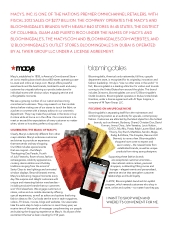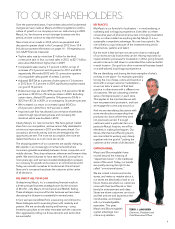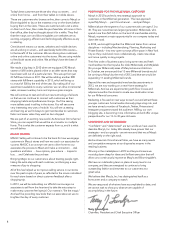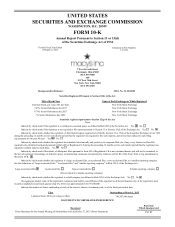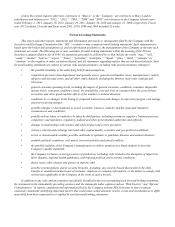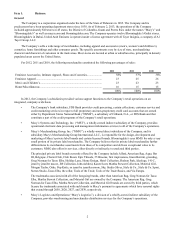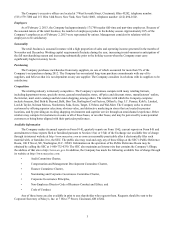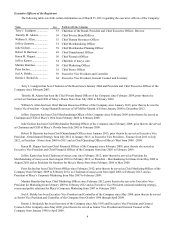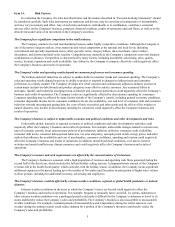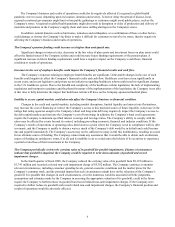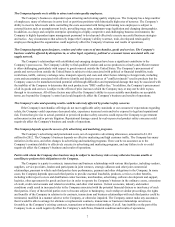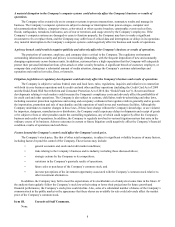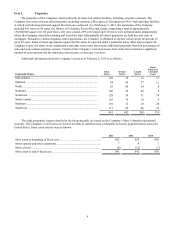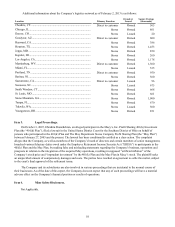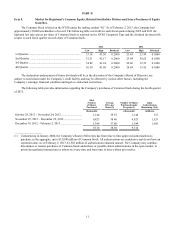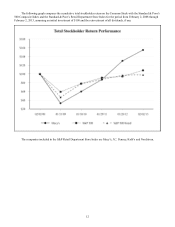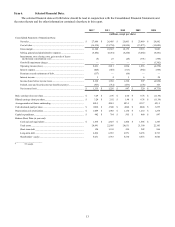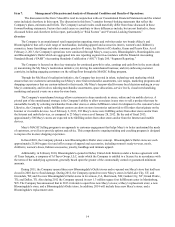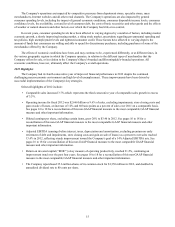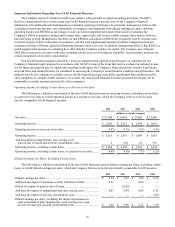Macy's 2012 Annual Report Download - page 11
Download and view the complete annual report
Please find page 11 of the 2012 Macy's annual report below. You can navigate through the pages in the report by either clicking on the pages listed below, or by using the keyword search tool below to find specific information within the annual report.6
The Company's business and results of operations could also be negatively affected if a regional or global health
pandemic were to occur, depending upon its location, duration and severity. To halt or delay the spread of disease, local,
regional or national governments might limit or ban public gatherings or customers might avoid public places, such as the
Company's stores. A regional or global health pandemic might also result in disruption or delay of production and delivery of
materials and products in the Company's supply chain and cause staffing shortages in the Company's stores.
In addition, natural disasters such as hurricanes, tornadoes and earthquakes, or a combination of these or other factors,
could damage or destroy the Company’s facilities or make it difficult for customers to travel to its stores, thereby negatively
affecting the Company’s business and results of operations.
The Company’s pension funding could increase at a higher than anticipated rate.
Significant changes in interest rates, decreases in the fair value of plan assets and investment losses on plan assets could
affect the funded status of the Company’s plans and could increase future funding requirements of the pension plans. A
significant increase in future funding requirements could have a negative impact on the Company’s cash flows, financial
condition or results of operations.
Increases in the cost of employee benefits could impact the Company’s financial results and cash flow.
The Company’s expenses relating to employee health benefits are significant. Unfavorable changes in the cost of such
benefits could negatively affect the Company’s financial results and cash flow. Healthcare costs have risen significantly in
recent years, and recent legislative and private sector initiatives regarding healthcare reform could result in significant changes
to the U.S. healthcare system. Due to the breadth and complexity of the healthcare reform legislation, the lack of implementing
regulations and interpretive guidance and the phased-in nature of the implementation of the legislation, the Company is not able
at this time to fully determine the impact that healthcare reform will have on the Company-sponsored medical plans.
Inability to access capital markets could adversely affect the Company’s business or financial condition.
Changes in the credit and capital markets, including market disruptions, limited liquidity and interest rate fluctuations,
may increase the cost of financing or restrict the Company’s access to this potential source of future liquidity. A decrease in the
ratings that rating agencies assign to the Company’s short and long-term debt may negatively impact the Company’s access to
the debt capital markets and increase the Company’s cost of borrowing. In addition, the Company’s bank credit agreements
require the Company to maintain specified interest coverage and leverage ratios. The Company’s ability to comply with the
ratios may be affected by events beyond its control, including prevailing economic, financial and industry conditions. If the
Company’s results of operations or operating ratios deteriorate to a point where the Company is not in compliance with its debt
covenants, and the Company is unable to obtain a waiver, much of the Company’s debt would be in default and could become
due and payable immediately. The Company’s assets may not be sufficient to repay in full this indebtedness, resulting in a need
for an alternate source of funding. The Company cannot make any assurances that it would be able to obtain such an alternate
source of funding on satisfactory terms, if at all, and its inability to do so could cause the holders of its securities to experience
a partial or total loss of their investments in the Company.
The Company periodically reviews the carrying value of its goodwill for possible impairment; if future circumstances
indicate that goodwill is impaired, the Company could be required to write down amounts of goodwill and record
impairment charges.
In the fourth quarter of fiscal 2008, the Company reduced the carrying value of its goodwill from $9,125 million to
$3,743 million and recorded a related non-cash impairment charge of $5,382 million. The Company continues to monitor
relevant circumstances, including consumer spending levels, general economic conditions and the market prices for the
Company’s common stock, and the potential impact that such circumstances might have on the valuation of the Company’s
goodwill. It is possible that changes in such circumstances, or in the numerous variables associated with the judgments,
assumptions and estimates made by the Company in assessing the appropriate valuation of its goodwill, could in the future
require the Company to further reduce its goodwill and record related non-cash impairment charges. If the Company were
required to further reduce its goodwill and record related non-cash impairment charges, the Company’s financial position and
results of operations would be adversely affected.


